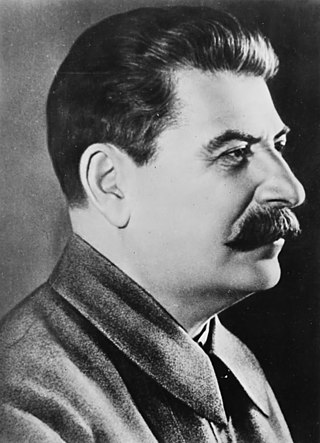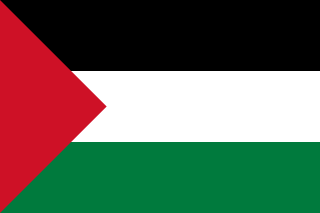Marxism–Leninism is a communist ideology that became the largest faction of the communist movement in the world in the years following the October Revolution. It was the predominant ideology of most communist governments throughout the 20th century. It was developed in Russia by Joseph Stalin and drew on elements of Bolshevism, orthodox Marxism, and Leninism. It was the state ideology of the Soviet Union, Soviet satellite states in the Eastern Bloc, and various countries in the Non-Aligned Movement and Third World during the Cold War, as well as the Communist International after Bolshevization.

Stalinism is the totalitarian means of governing and Marxist–Leninist policies implemented in the Soviet Union (USSR) from 1927 to 1953 by dictator Joseph Stalin. Stalin had previously made a career as a gangster and robber, working to fund revolutionary activities, before eventually becoming General Secretary of the Soviet Union. Stalinism included the creation of a one man totalitarian police state, rapid industrialization, the theory of socialism in one country, forced collectivization of agriculture, intensification of class conflict, a cult of personality, and subordination of the interests of foreign communist parties to those of the Communist Party of the Soviet Union, which Stalinism deemed the leading vanguard party of communist revolution at the time. After Stalin's death and the Khrushchev Thaw, a period of de-Stalinization began in the 1950s and 1960s, which caused the influence of Stalin's ideology to begin to wane in the USSR.

The Great Purge, or the Great Terror, also known as the Year of '37 and the Yezhovshchina, was Soviet General Secretary Joseph Stalin's campaign to consolidate his power over the Communist Party of the Soviet Union and Soviet state. The purges also sought to remove the remaining influence of Leon Trotsky. The term great purge, an allusion to the French Revolution's Reign of Terror, was popularized by the historian Robert Conquest in his 1968 book The Great Terror.
The interwar Communist Party of Poland was a communist party active in Poland during the Second Polish Republic. It resulted from a December 1918 merger of the Social Democracy of the Kingdom of Poland and Lithuania (SDKPiL) and the Polish Socialist Party – Left into the Communist Workers' Party of Poland. The communists were a small force in Polish politics.

The Cold War originated in the breakdown of relations between the two main victors in World War II: United States and the Soviet Union, and their respective allies, the Western Bloc and the Eastern Bloc, in the years 1945–1949.

Anastas Ivanovich Mikoyan was an Armenian Communist revolutionary, Old Bolshevik and Soviet statesman. Having been elected to the Central Committee in 1923, he was the only Soviet politician who managed to remain at the highest levels of power within the Communist Party from the latter days of Lenin, through the eras of Stalin and Khrushchev, to his peaceful retirement under Brezhnev.

A show trial is a public trial in which the guilt or innocence of the defendant has already been determined. The purpose of holding a show trial is to present both accusation and verdict to the public, serving as an example and a warning to other would-be dissidents or transgressors.
A fellow traveller is a person who is intellectually sympathetic to the ideology of a political organization, and who co-operates in the organization's politics, without being a formal member. In the early history of the Soviet Union, the Bolshevik revolutionary and Soviet statesman Anatoly Lunacharsky coined the term poputchik and later it was popularized by Leon Trotsky to identify the vacillating intellectual supporters of the Bolshevik government. It was the political characterisation of the Russian intelligentsiya who were philosophically sympathetic to the political, social, and economic goals of the Russian Revolution of 1917, but who did not join the Communist Party of the Soviet Union. The usage of the term poputchik disappeared from political discourse in the Soviet Union during the Stalinist era, but the Western world adopted the English term fellow traveller to identify people who sympathised with the Soviets and with Communism.
The history of communism encompasses a wide variety of ideologies and political movements sharing the core principles of common ownership of wealth, economic enterprise, and property. Most modern forms of communism are grounded at least nominally in Marxism, a theory and method conceived by Karl Marx and Friedrich Engels during the 19th century. Marxism subsequently gained a widespread following across much of Europe, and throughout the late 1800s its militant supporters were instrumental in a number of unsuccessful revolutions on that continent. During the same era, there was also a proliferation of communist parties which rejected armed revolution, but embraced the Marxist ideal of collective property and a classless society.
The actions by governments of communist states have been subject to criticism across the political spectrum. Communist party rule has been especially criticized by anti-communists and right-wing critics, but also by other socialists such as anarchists, democratic socialists, libertarian socialists, orthodox Marxists, and Trotskyist communists. Ruling communist parties have also been challenged by domestic dissent. According to the critics, rule by communist parties has often led to totalitarianism, political repression, restrictions of human rights, poor economic performance, and cultural and artistic censorship.
The Organisation for the Maintenance of Supplies was a British right-wing movement, established in 1925 to provide volunteers in the event of a general strike. During the General Strike of 1926, it was taken over by the government to provide vital services, such as transport and communications.

Dekulakization was the Soviet campaign of political repressions, including arrests, deportations, or executions of millions of kulaks and their families. Redistribution of farmland started in 1917 and lasted until 1933, but was most active in the 1929–1932 period of the first five-year plan. To facilitate the expropriations of farmland, the Soviet government announced the "liquidation of the kulaks as a class" on 27 December 1929, portraying kulaks as class enemies of the Soviet Union.

Kim Il Sung was a North Korean politician and the founder of North Korea, which he led as Supreme Leader from the country's establishment in 1948 until his death in 1994. Afterwards, he was declared eternal president.

The Ramadan Revolution, also referred to as the 8 February Revolution and the February 1963 coup d'état in Iraq, was a military coup by the Iraqi branch of the Ba'ath Party which overthrew the Prime Minister of Iraq, Abdul-Karim Qasim in 1963. It took place between 8 and 10 February 1963. Qasim's former deputy, Abdul Salam Arif, who was not a Ba'athist, was given the largely ceremonial title of President, while prominent Ba'athist general Ahmed Hassan al-Bakr was named Prime Minister. The most powerful leader of the new government was the secretary general of the Iraqi Ba'ath Party, Ali Salih al-Sa'di, who controlled the National Guard militia and organized a massacre of hundreds—if not thousands—of suspected communists and other dissidents following the coup.

Eastern Bloc politics followed the Red Army's occupation of much of Central and Eastern Europe at the end of World War II and the Soviet Union's installation of Soviet-controlled Marxist–Leninist governments in the region that would be later called the Eastern Bloc through a process of bloc politics and repression. These governments contained apparent elements of representative democracy to conceal the process initially.

De-Ba'athification refers to a policy undertaken in Iraq by the Coalition Provisional Authority (CPA) and subsequent Iraqi governments to remove the Ba'ath Party's influence in the new Iraqi political system after the U.S.-led invasion in 2003. It was considered by the CPA to be Iraq's equivalent to Germany's denazification after World War II. It was first outlined in CPA Order 1 which entered into force on 16 May 2003. The order declared that all public sector employees affiliated with the Ba'ath Party were to be removed from their positions and to be banned from any future employment in the public sector.

The Arab Socialist Ba'ath Party – Iraq Region, officially the Iraqi Regional Branch, is an Iraqi Ba'athist political party founded in 1951 by Fuad al-Rikabi. It was the Iraqi regional branch of the original Ba'ath Party, before changing its allegiance to the Iraqi-dominated Ba'ath movement following the 1966 split within the original party. The party was officially banned following the American invasion of Iraq in 2003, but despite this it still continues to function underground.
Purges of the Communist Party in the Soviet Union were Soviet political events, especially during the 1920s, in which periodic reviews of members of the Communist Party were conducted by other members and the security organs to get rid of "undesirables". Such reviews would start with a short autobiography from the reviewed person and then an interrogation of him or her by the purge commission, as well as by the attending audience. Although many people were victims of the purge throughout this decade, the general Soviet public was not aware of the purge until 1937.

The People's Commissariat for Internal Affairs, abbreviated NKVD, was the interior ministry of the Soviet Union.
The Red Purge was an anticommunist movement in occupied Japan from the late 1940s to the early 1950s. Carried out by the Japanese government and private corporations with the aid and encouragement of the Supreme Commander for the Allied Powers (SCAP), the Red Purge saw tens of thousands of alleged members, supporters, or sympathizers of left-wing groups, especially those said to be affiliated with the Japanese Communist Party, removed from their jobs in government, the private sector, universities, and schools. The Red Purge emerged from rising Cold War tensions and the Red Scare after World War II, and was a significant element within a broader "Reverse Course" in Occupation policies. The Red Purge reached a peak following the outbreak of the Korean War in 1950, began to ease after General Douglas MacArthur was replaced as commander of the Occupation by General Matthew Ridgway in 1951, and came to a final conclusion with the end of the Occupation in 1952.











